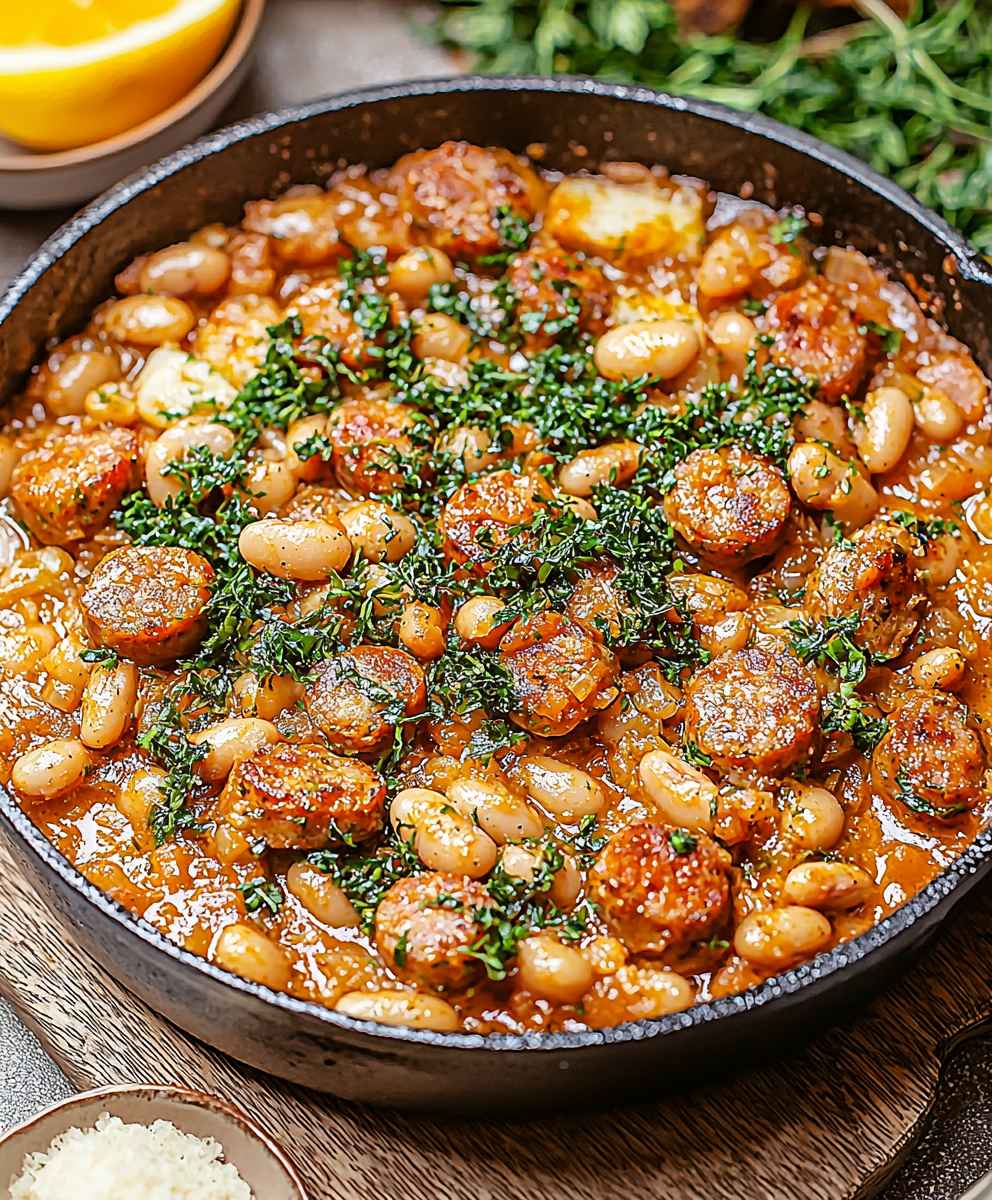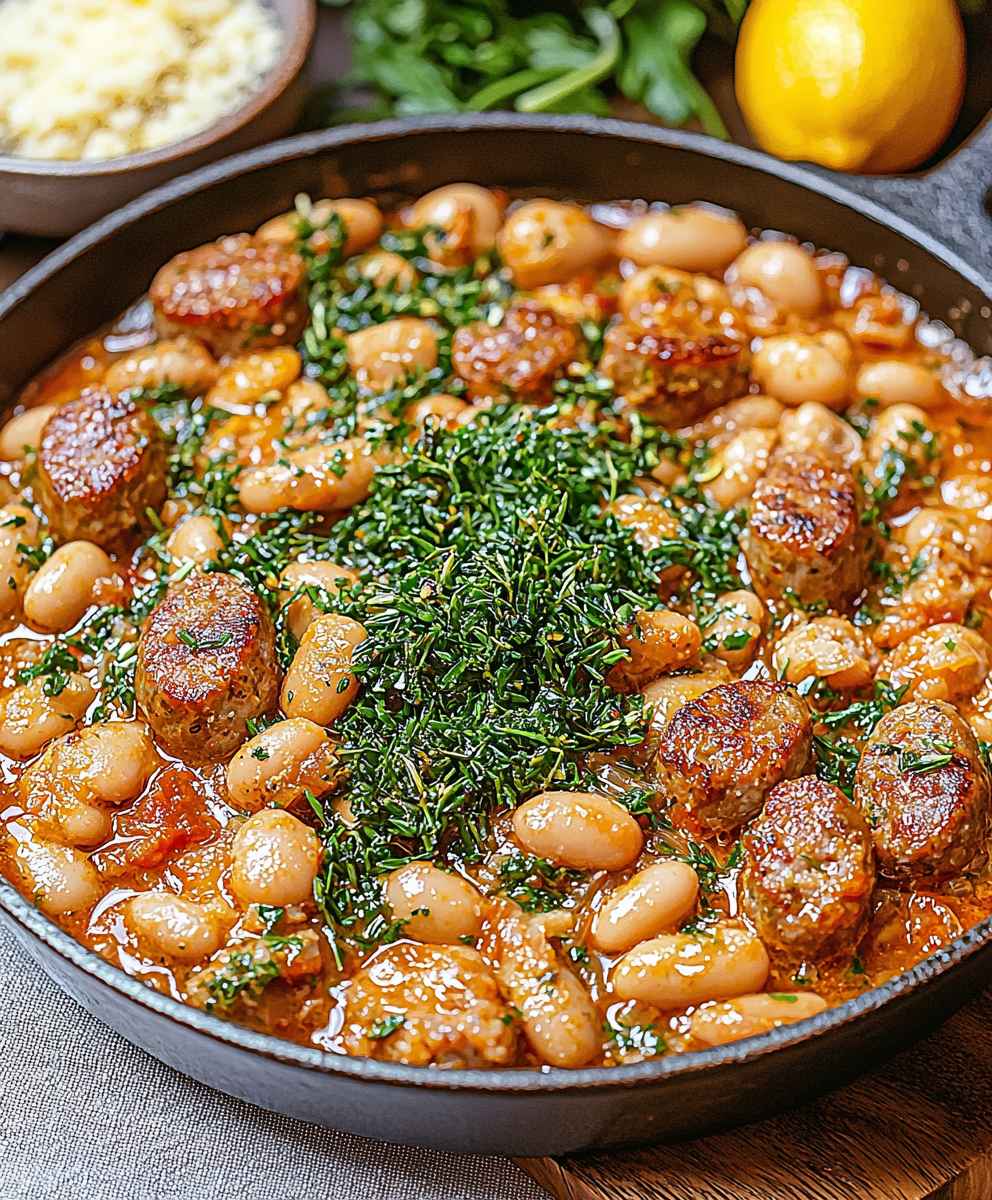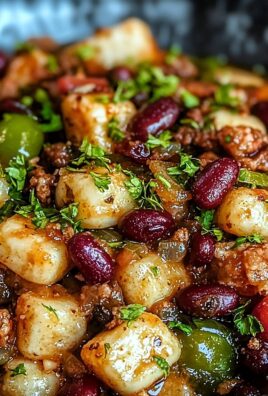Sausage white bean skillet: it’s not just dinner; it’s a culinary hug in a pan! Imagine this: savory browned sausage mingling with creamy white beans, all simmered in a flavorful broth with aromatic herbs. This isn’t some newfangled invention, though. Dishes featuring beans and sausage have been staples in rustic cuisines around the world for centuries, particularly in Mediterranean and European cultures. Think of the hearty cassoulets of France or the comforting stews of Italy this skillet dish shares that same soul.
What makes a sausage white bean skillet so universally loved? It’s the perfect marriage of textures and tastes. The slight chewiness of the sausage contrasts beautifully with the smooth, almost buttery texture of the white beans. The savory richness is balanced by the freshness of herbs like rosemary and thyme. But beyond the deliciousness, it’s incredibly convenient. This one-pan wonder comes together quickly, making it ideal for busy weeknights. Plus, it’s endlessly adaptable feel free to add your favorite vegetables or spices to make it your own. So, are you ready to experience the comforting magic of this dish? Let’s get cooking!
Ingredients:
- 1 pound Italian sausage (sweet or hot, casings removed)
- 1 large onion, chopped
- 2 cloves garlic, minced
- 1 red bell pepper, chopped
- 1 (15-ounce) can cannellini beans, rinsed and drained
- 1 (14.5-ounce) can diced tomatoes, undrained
- 1 cup chicken broth
- 1 teaspoon dried oregano
- 1/2 teaspoon dried basil
- 1/4 teaspoon red pepper flakes (optional)
- Salt and pepper to taste
- 2 tablespoons olive oil
- Fresh parsley, chopped (for garnish)
- Crusty bread, for serving (optional)
Preparing the Sausage and Vegetables
- Get started by heating the olive oil in a large skillet over medium heat. I like to use a cast-iron skillet for this recipe because it distributes the heat evenly, but any large skillet will work just fine.
- Once the oil is shimmering, add the Italian sausage. Break it up with a spoon as it cooks. Cook until the sausage is browned and cooked through, about 7-10 minutes. Make sure to stir it occasionally to prevent sticking and ensure even cooking.
- Remove the sausage from the skillet with a slotted spoon and set it aside. Leave any rendered fat in the skillet this will add flavor to the vegetables. If there’s an excessive amount of fat, you can drain off a little, leaving about a tablespoon or two.
- Add the chopped onion and red bell pepper to the skillet. Cook until softened, about 5-7 minutes. Stir occasionally to prevent burning. You want the onions to become translucent and the bell pepper to soften slightly.
- Add the minced garlic and cook for another minute, until fragrant. Be careful not to burn the garlic, as it can become bitter. Stir constantly during this step.
Combining the Ingredients and Simmering
- Return the cooked sausage to the skillet with the vegetables. Stir to combine everything. This is where all the delicious flavors start to meld together.
- Add the cannellini beans, diced tomatoes (with their juice), chicken broth, dried oregano, dried basil, and red pepper flakes (if using). Stir well to incorporate all the ingredients.
- Season with salt and pepper to taste. Remember that the sausage may already be salty, so start with a small amount and adjust as needed. I usually start with about 1/2 teaspoon of salt and 1/4 teaspoon of pepper, then taste and adjust.
- Bring the mixture to a simmer. Reduce the heat to low, cover the skillet, and let it simmer for at least 15-20 minutes. This allows the flavors to meld together even more and the sauce to thicken slightly. Stir occasionally to prevent sticking.
- If you want a thicker sauce, you can simmer the skillet uncovered for the last 5-10 minutes. This will allow some of the liquid to evaporate.
Serving the Sausage White Bean Skillet
- Before serving, give the skillet a final stir and taste to adjust the seasoning if needed. Add more salt, pepper, or red pepper flakes to your liking.
- Garnish with fresh chopped parsley. The fresh parsley adds a pop of color and a bright, fresh flavor that complements the richness of the skillet.
- Serve hot, directly from the skillet. I love to serve this with crusty bread for dipping into the delicious sauce. You can also serve it over rice, pasta, or polenta.
- This skillet is also great served with a dollop of sour cream or Greek yogurt on top. The tanginess of the dairy adds a nice contrast to the savory flavors.
Tips and Variations
- Spice it up: If you like a little more heat, use hot Italian sausage or add more red pepper flakes. You can also add a pinch of cayenne pepper.
- Add more vegetables: Feel free to add other vegetables to the skillet, such as zucchini, spinach, or kale. Add them along with the bell pepper and onion.
- Use different beans: If you don’t have cannellini beans, you can use other types of beans, such as great northern beans, kidney beans, or chickpeas.
- Make it vegetarian: To make this recipe vegetarian, substitute the Italian sausage with plant-based sausage or omit it altogether. You may need to add a little extra olive oil to compensate for the fat from the sausage.
- Add wine: For a richer flavor, add 1/2 cup of dry red or white wine to the skillet after cooking the vegetables. Let it simmer for a few minutes to reduce before adding the remaining ingredients.
- Make it ahead: This skillet can be made ahead of time and reheated. The flavors actually improve as it sits. Store it in an airtight container in the refrigerator for up to 3 days.
- Freeze it: This skillet also freezes well. Let it cool completely before transferring it to a freezer-safe container. Freeze for up to 2 months. Thaw overnight in the refrigerator before reheating.
Serving Suggestions
- Serve with crusty bread: As mentioned before, crusty bread is perfect for soaking up the delicious sauce.
- Serve over rice: This skillet is also great served over white or brown rice.
- Serve over pasta: Toss the skillet with your favorite pasta shape, such as penne, rigatoni, or farfalle.
- Serve over polenta: Creamy polenta is a delicious base for this skillet.
- Serve with a side salad: A simple green salad with a vinaigrette dressing is a refreshing accompaniment to this hearty skillet.
Nutritional Information (Approximate)
(Note: Nutritional information is an estimate and may vary based on specific ingredients and portion sizes.)
- Calories: Approximately 400-500 per serving
- Protein: 25-35 grams
- Fat: 20-30 grams
- Carbohydrates: 30-40 grams
Why I Love This Recipe
This Sausage White Bean Skillet is one of my go-to recipes for a quick, easy, and satisfying meal. I love that it’s packed with flavor and comes together in under an hour. It’s also incredibly versatile you can easily customize it to your liking by adding different vegetables, beans, or spices. Plus, it’s a great way to use up leftover ingredients in your fridge. And the best part? It’s a crowd-pleaser! Everyone who tries it always raves about it. I hope you enjoy it as much as I do!

Conclusion:
This Sausage White Bean Skillet isn’t just another weeknight dinner; it’s a flavor explosion waiting to happen! I genuinely believe this recipe deserves a spot in your regular rotation. Why? Because it’s quick, satisfying, and incredibly versatile. The combination of savory sausage, creamy white beans, and those perfectly browned vegetables creates a symphony of textures and tastes that will leave you wanting more. Plus, cleanup is a breeze always a win in my book!
But the real magic lies in its adaptability. Feel free to experiment with different types of sausage. Spicy Italian sausage will add a fiery kick, while sweet Italian sausage offers a more mellow, comforting flavor. Chorizo would also be a fantastic addition, lending a smoky depth to the dish. And don’t be afraid to play around with the vegetables! Bell peppers, zucchini, or even some chopped kale would all work beautifully in this skillet.
Looking for serving suggestions? This Sausage White Bean Skillet is delicious on its own, served directly from the pan. But if you want to elevate it further, try serving it over a bed of creamy polenta or fluffy couscous. A dollop of Greek yogurt or sour cream adds a tangy coolness that complements the richness of the dish. For a lighter option, serve it alongside a simple green salad with a lemon vinaigrette. And if you’re feeling extra fancy, sprinkle some crumbled feta cheese or grated Parmesan cheese on top for a salty, savory finish.
Another variation I love is adding a can of diced tomatoes (drained) for a bit of acidity and sweetness. A squeeze of fresh lemon juice at the end brightens up all the flavors and adds a zesty touch. And if you’re a fan of spice, a pinch of red pepper flakes will definitely kick things up a notch.
I’ve made this Sausage White Bean Skillet countless times, and each time I tweak it slightly based on what I have on hand and what I’m craving. That’s the beauty of this recipe it’s a blank canvas for your culinary creativity!
So, what are you waiting for? I urge you to give this recipe a try. I’m confident that you’ll love it as much as I do. It’s the perfect solution for busy weeknights when you want a delicious and satisfying meal without spending hours in the kitchen.
Once you’ve made it, I’d absolutely love to hear about your experience! Did you make any modifications? What did you serve it with? What did your family think? Share your thoughts and photos in the comments below. Your feedback is invaluable, and it helps other readers discover new and exciting ways to enjoy this fantastic dish. Let’s create a community of Sausage White Bean Skillet enthusiasts! Happy cooking!
Sausage White Bean Skillet: A Delicious and Easy One-Pan Meal
Hearty Sausage White Bean Skillet with Italian sausage, cannellini beans, and vegetables in a savory tomato broth. A quick and easy one-pan meal!
Ingredients
- 1 pound Italian sausage (sweet or hot, casings removed)
- 1 large onion, chopped
- 2 cloves garlic, minced
- 1 red bell pepper, chopped
- 2 tablespoons olive oil
- 1 (15-ounce) can cannellini beans, rinsed and drained
- 1 (14.5-ounce) can diced tomatoes, undrained
- 1 cup chicken broth
- 1 teaspoon dried oregano
- 1/2 teaspoon dried basil
- 1/4 teaspoon red pepper flakes (optional)
- Salt and pepper to taste
- Fresh parsley, chopped (for garnish)
- Crusty bread, for serving (optional)
Instructions
- Heat the olive oil in a large skillet over medium heat.
- Add the Italian sausage and break it up with a spoon. Cook until browned and cooked through, about 7-10 minutes, stirring occasionally.
- Remove the sausage from the skillet with a slotted spoon and set aside. Leave the rendered fat in the skillet (drain off excess if needed, leaving about 1-2 tablespoons).
- Add the chopped onion and red bell pepper to the skillet. Cook until softened, about 5-7 minutes, stirring occasionally.
- Add the minced garlic and cook for another minute, until fragrant, stirring constantly.
- Return the cooked sausage to the skillet with the vegetables. Stir to combine.
- Add the cannellini beans, diced tomatoes (with their juice), chicken broth, dried oregano, dried basil, and red pepper flakes (if using). Stir well.
- Season with salt and pepper to taste.
- Bring the mixture to a simmer. Reduce the heat to low, cover the skillet, and let it simmer for at least 15-20 minutes, stirring occasionally.
- If you want a thicker sauce, you can simmer the skillet uncovered for the last 5-10 minutes.
- Before serving, give the skillet a final stir and taste to adjust the seasoning if needed.
- Garnish with fresh chopped parsley.
- Serve hot, directly from the skillet, with crusty bread, rice, pasta, or polenta.
Notes
- Spice it up: Use hot Italian sausage or add more red pepper flakes for extra heat.
- Add more vegetables: Zucchini, spinach, or kale can be added along with the bell pepper and onion.
- Use different beans: Great northern beans, kidney beans, or chickpeas can be substituted for cannellini beans.
- Make it vegetarian: Substitute the Italian sausage with plant-based sausage or omit it altogether. Add a little extra olive oil if needed.
- Add wine: For a richer flavor, add 1/2 cup of dry red or white wine to the skillet after cooking the vegetables. Let it simmer for a few minutes to reduce before adding the remaining ingredients.
- Make it ahead: This skillet can be made ahead of time and reheated. Store it in an airtight container in the refrigerator for up to 3 days.
- Freeze it: This skillet also freezes well. Let it cool completely before transferring it to a freezer-safe container. Freeze for up to 2 months. Thaw overnight in the refrigerator before reheating.






Leave a Comment